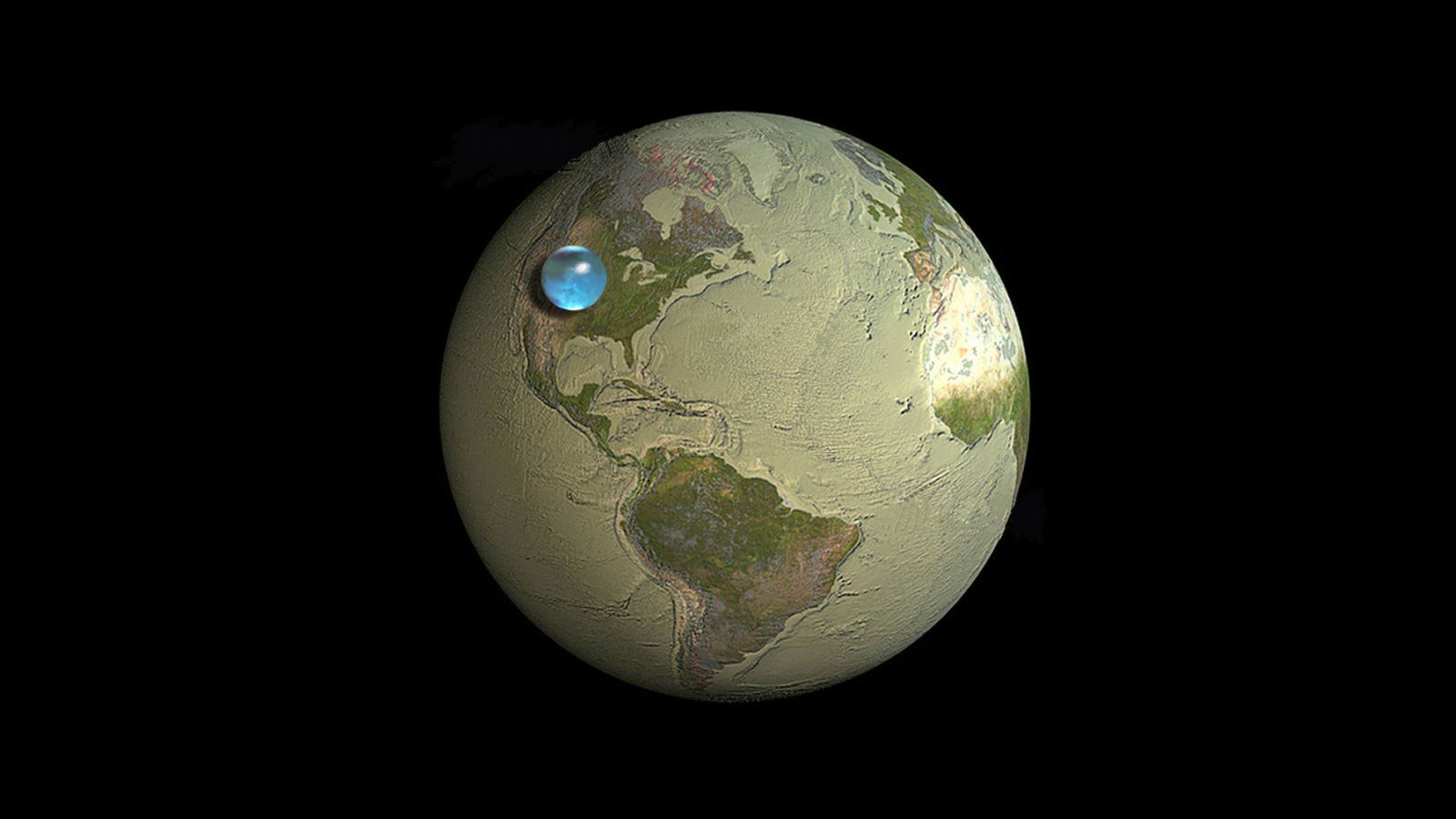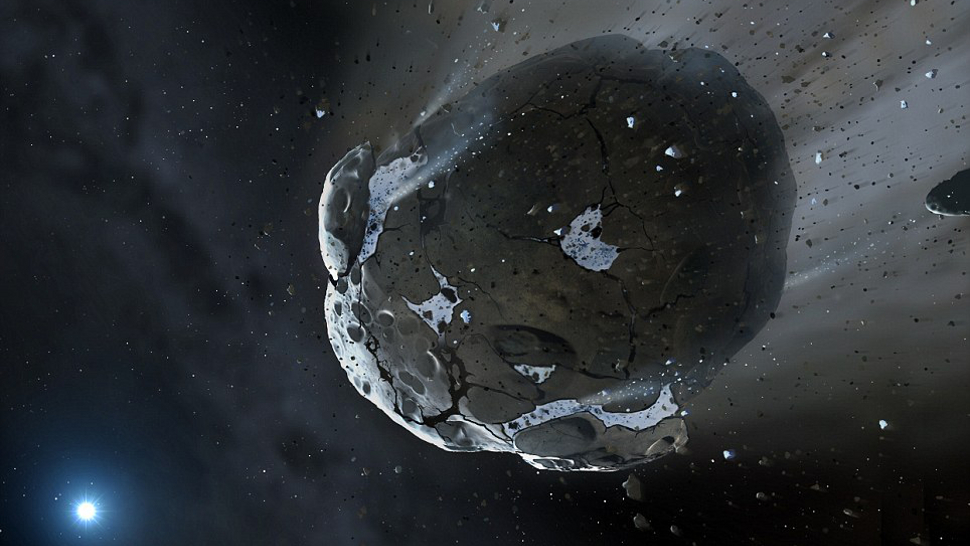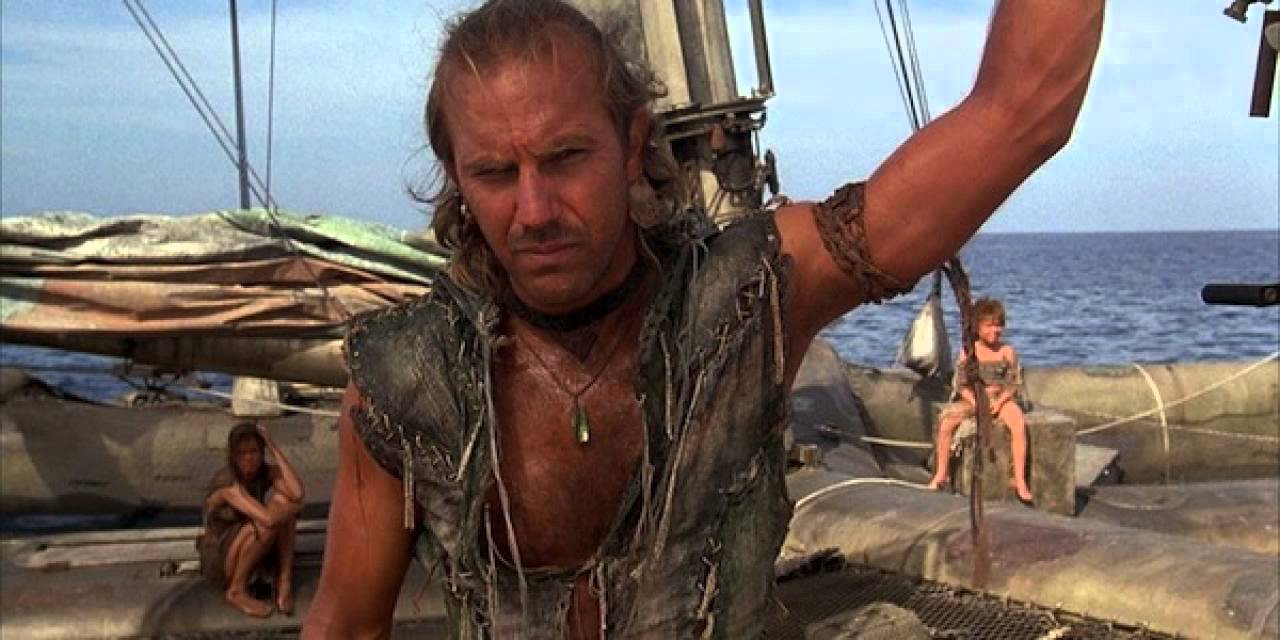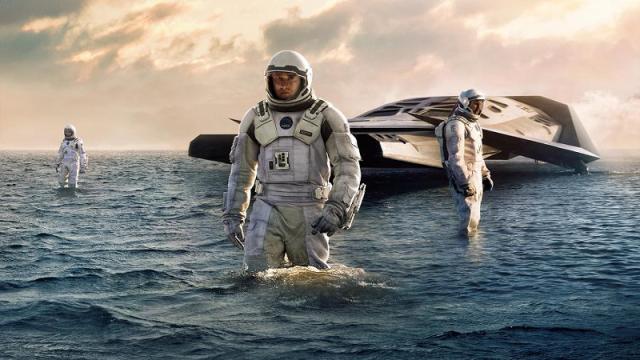Over 70 per cent of our planet is covered in water, and we tend to think that’s a lot. A new study suggests that our world is special in this regard, and that most habitable planets are dominated by oceans that consume over 90 per cent their surface area. That may be good for primitive marine life, but not so good for aspiring civilisations.
More common than you might think. (Image: Interstellar)
A new study published in The Monthly Notices of the Royal Astronomical Society suggests that most habitable planets are wet. Like, extremely wet. Using computer models, astronomer Fergus Simpson from the Institute of Cosmos Science at the University of Barcelona found that habitable exoplanets, at least simulated ones, tend to be overrun by water, in most cases accounting for 90 per cent or more of the total surface area.
This finding suggests that Earth, with its vast land masses, is unique in the cosmological scheme of things, and that our planetary twin may be harder to find than we thought. What’s more, it may explain why we’ve never made contact with an extraterrestrial intelligence — a conclusion that feeds into the Rare Earth Hypothesis, the idea that Earth-like planets containing complex life are exceptionally rare in the Universe.

This USGS picture shows the size of a sphere that would contain all of Earth’s water in comparison to the size of the Earth. It may not seem like much, but our planet is relatively flat, so a little goes a long way. (Image: USGS)
As Simpson notes in his new study, a planet must strike a certain balance if it is to host both extensive land masses and large oceans. Factors controlling this balance include the amount of water on the surface of a planet, the space available to store it, and the presence of dynamic topographical features — from vast ocean basins through to mountain ranges. If the oceans are relatively shallow, and the land altitudes low, the excess water will consume the vast majority of a planet’s surface. Here on Earth, the global topography allows for approximately 29 per cent of our planet’s surface area to remain above water. Over the aeons, this ratio has remained relatively stable, allowing for the emergence of complex terrestrial animals such as ourselves.
Simpson’s new study suggests that Earth is an outlier in this regard, and that most terrestrial planets locked within its host star’s habitable zone (that is, that cosy niche where liquid water can be retained at the surface) are waterworlds. But if we take a closer look at our planet, we’re actually not too far removed from being completely drenched in water ourselves. As the animation below shows, only a narrow window exists in which large areas of both land and water are present. Consequently, and as Simpson points out in his new study, habitable exoplanets tend to be dominated by water or land.
At least in theory. Simpson’s models aren’t based on observations made of real exoplanets, and are instead best guesses of planetary formation and how much water we can expect to find on these hypothetical worlds.
“I’m a bit puzzled about this paper,” said astrophysicist Sean N. Raymond, who wasn’t involved with the study, in an interview with Gizmodo. “I find studies that extrapolate from N=1 to be interesting but hard to interpret. In this case, there are plenty of unanswered — but relevant questions.”

Indeed, the question of how planets get their water is still a matter of contention. The prevailing theory is that most of Earth’s water was delivered by asteroids and comets. If that’s the case, then it’s nearly impossible to predict the quantity of water on any given planet. In order for us to be certain, we’d need to know the average amount of water delivered to a planet of our size and location. But every star system is different, featuring varying amounts of asteroids, comets and water, not to mention neighbouring planets that are also sopping up water from the heavens.
“In the ‘classical model’ of terrestrial planet formation, water delivery to Earth is very [random] so it’s reasonable to imagine alternate Earths with over 10 times more water,” said Raymond. “However, in our newer models much less water is delivered but the delivery is more reliable.”
What Raymond is talking about is the observation that the inner solar system is water poor, while the outer system is water-rich.
“Water worlds are always beyond what we call the ‘snow line’,” Adam Sarafian, a graduate student at MIT’s Earth, Atmospheric and Planetary Sciences department, told Gizmodo. “The snow line existed in the very early Solar System before planets formed. Beyond the line, water could condense as ice, so the bodies in the outer solar system are water rich and the inner solar system bodies are water poor. So we would expect water worlds to exist in the outer solar system and relatively dry planets in the inner solar system.”
Sarafian, who wasn’t involved with the new study, is currently trying to figure out why Earth has so much water and when it got here.
“Recent evidence suggests the inner solar system was likely seeded with plenty of water very early, such that Mars could have looked just like Earth (partly waterworld) soon after it formed,” said Sarafian. “One advantage of looking at planets closer to the Sun, which wouldn’t allow them to be water worlds (because of the snow line) is that the sun provides a lot of energy for life and would allow liquid water on the surface, as opposed to ice.”
Sarafian believes that Simpson’s new study is part of this larger conversation, which is mostly speculation about the best places to look for life.

Waterworld was a crappy movie, but at least it got the science right.
But there are other factors to consider than how Earth got its water, such as how the ocean’s depths are regulated by interactions between the deep ocean and Earth’s mantle. For example, Earth may be unique in that it features unusually deep water basins. More research will be required to determine if this is the case.
Simpson himself factored in some of these effects, and had his test model account for the deep water cycle, erosion and deposition processes (that is, the process in which sediments, soil and rocks are added to a land mass). Despite this, he still found that water is be a prevailing surface feature in most cases. Interestingly, he found that planets with small oceans feature land masses dominated by deserts. Also, large Earth-like planets are almost guaranteed to be waterworlds.
“Larger planets are thought to be more prone to flooding for two reasons,” Simpson told Gizmodo. “One is that if they have the same composition (percentage of water by mass) then their oceans are deeper. The second is that their higher surface gravity makes it harder to have such large surface perturbations [dynamic topological features].”
If Simpson’s conclusions are valid, then it means our planet has struck a fine balance between land and ocean — an observation that may help to explain why our civilisation emerged on Earth (despite what some might say, it is highly unlikely that a high-tech, industrial-scale civilisation can develop on a world consumed by water). And in fact, Simpson says that anthropic selection effects are at work. That’s a fancy way of saying that Earth is a freaky planet, because if it wasn’t freaky, we wouldn’t be here to see it.
The trouble with the Anthropic Principle, of course, is that it’s untestable. But thankfully, this new waterworld theory is.
“The exciting aspect is that we may not be too far from measuring the atmospheric composition of terrestrial exoplanets,” said Simpson. Indeed, with the next generation of telescopes, including those situated in space, we’ll be able to scan the atmospheres of exoplanets to determine how much water might be on the surface.
In addition, scientists will need to figure out the various ways in which our planet is weird, and why. Until then, let’s celebrate the fact that Earth is a weirdo of the Milky Way.
